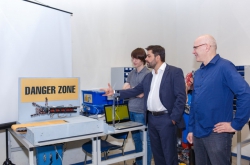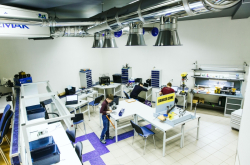Forester — a forest pathologist robot.
Daniil Nechaev, award winner of the recent World Robot Olympiad, has been working on his new project for a week now. For the last competition, he and his teammates constructed a robotic hand that used the Leap Motion 3D-sensor to copy its operator's hand movements, thus making work with hazardous materials safer. Their Nuclear Waste Taker project got 2nd place in the World Robot Olympiad in New Delhi.
The new invention has to do with ecology, as well: the Forester walking robot or the "forest pathologist", as they sometimes call it, can replace up to ten people in monitoring a forest's condition: gather relevant information on the trees' condition, define areas for sanitation harvest and even prevent forest fires.
The robot works as follows: first, a quadcopter brings the robot to a desired area. Then, after uncoupling from it, the robot uses its sensors to define the trees' condition. Using special algorithms and a camera, it learns its location and can thus plot its route, as well as define the types of trees it’s working with, — explain the project's authors, Daniil Nechaev and Maksim Mikhailov.

ITMO University. Daniil Nechaev and Maksim Mikhailov
The project is a response to the new task of the World Robot Olympiad; this time, it will take place in Costa Rica. Participating in its Open category implies creating robots for one of the four relevant goals: affordable and clean energy, sustainable cities and communities, climate action and life on land.
"Right after the new topics were published, we started to think what kind of robot we will be creating this time. We've browsed through data from different sources and saw this video where people walk through a forest carrying instruments, make measurements and write everything down. So, we've decided — why do people have to do this work when robots can do that. This is how we got the idea of a robot that can map the forest, gather data, define areas for sanitation harvest and the like. What is more, while the robot is flying to the desired area, it can watch out for smoke and thus prevent forest fires", shares Daniil Nechaev.
Forester already can get up and sit down — all in all, it will use eight actuating motors to move. The project's authors have three weeks to complete their work — in April, Forester will already compete in the city-level contests. Before going to Costa Rica, it will have to win the All-Russian Robot Olympics in Innopolis, as well.
 ITMO's Robotic Center
ITMO's Robotic Center
Graffiti cleaner, ArtBot and selfie-loving Seldon
ITMO's school team has two more projects that it plans to take to the WRO. One is a robot that can distinguish graffiti from useful information. So far, its developers only taught it to erase graffiti that ruins a building's image; yet, they are planning to teach it to use the corresponding color to cover the graffiti, so that the building's original look will be restored.
The authors of the third project are laboratory's youngest members — the 10−12 year old children work on a robotic guide for the blind. The device is to be fixed on a cane, and can guide a person along a particular route while alerting him to any possible obstructions.
 ITMO's Robotic Center
ITMO's Robotic Center
Another prize winner of last year's WRO, tenth grader Levon Pogosov prepares for his first RoboGames in the USA. For one of the world's biggest competitions in robotics, he will bring a decorator robot that hand paints balloons.
"At RoboGames, there's this special ArtBot section that has to do with "creative" robots, and art. Our project falls into this category, comments the student. There are few American teams in competitions we usually participate in, so RoboGames will show us the projects which are completed in the USA and help us understand the overall level of the world's student robotics"
Apart from projects for competitions, the Center's students work on many other ideas. For instance, Daniil Nechaev and Maksim Mikhailov also work on an anthropomorphic robot that will move independently and interact with people. So far, Seldon can only learn from others, and answer a limited number of questions, like "Why were you created?" or "Who the hell are you?". Yet, in the future, its creators aspire to make him discuss complex topics and even propose making selfies with him.
 ITMO's Robotic Center
ITMO's Robotic Center
Where do students get their ideas, and how do they put them into practice?
As of now, about 20 school students work in the Center — those are champions and award winners of different robotic contests and winners of competitions in Physics. Yet, even fifth graders can join the Center, if they know the fundamentals of robotics and want to apply this knowledge. Here, they can understand what they want to do in the future — become "pure" programmers, engineers, or combine these fields of knowledge, explains Igor Lositskiy, trainer of ITMO's school team in robotics.
What's more, by working in the lab, schoolers with considerable background in robotics can bridge gaps in other fields of knowledge. For instance, there's the course on machine vision on Saturdays, and there will soon be a special course for those who want to do projects on Arduino.
 ITMO University. Igor Lositskiy
ITMO University. Igor Lositskiy
"Most importantly, such programs help one learn to think creatively. What we have here is something between a research lab and an artist's studio. We work on different tasks — be it for some competition or not, we want to use our skills and resources to create something new, something we've dreamt up. Also, it is a place where children gather and interact, which will help build communication in the future. We have kids who can persuade you in almost anything. Thus, even if they don't plan on doing robotics for life, the skills they get here will certainly come in handy in the future," notes Igor Lositskiy.
ITMO's students help their younger colleagues with the most complex ideas. For example, during the work on Nuclear Waste Taker, the more experienced developers showed how to correct a mistake in calculations and let the robotic hand manipulate objects more freely, shares Alexandr Kapitonov, teaching fellow at ITMO's Department of Computer Science and Control Systems. In the future, such collaborations may result in serious projects, as well as creating mixed teams for participating in competitions, adds Igor Lositskiy.






